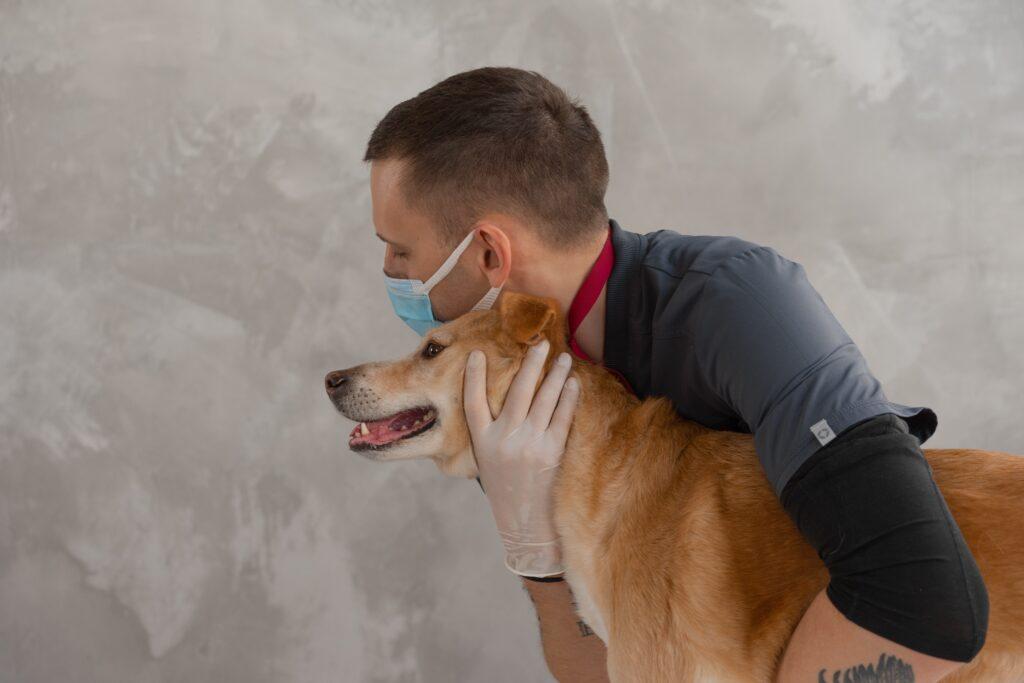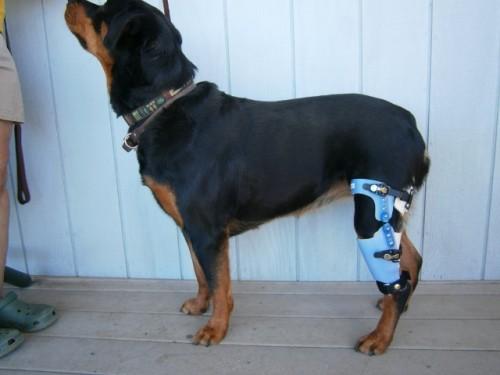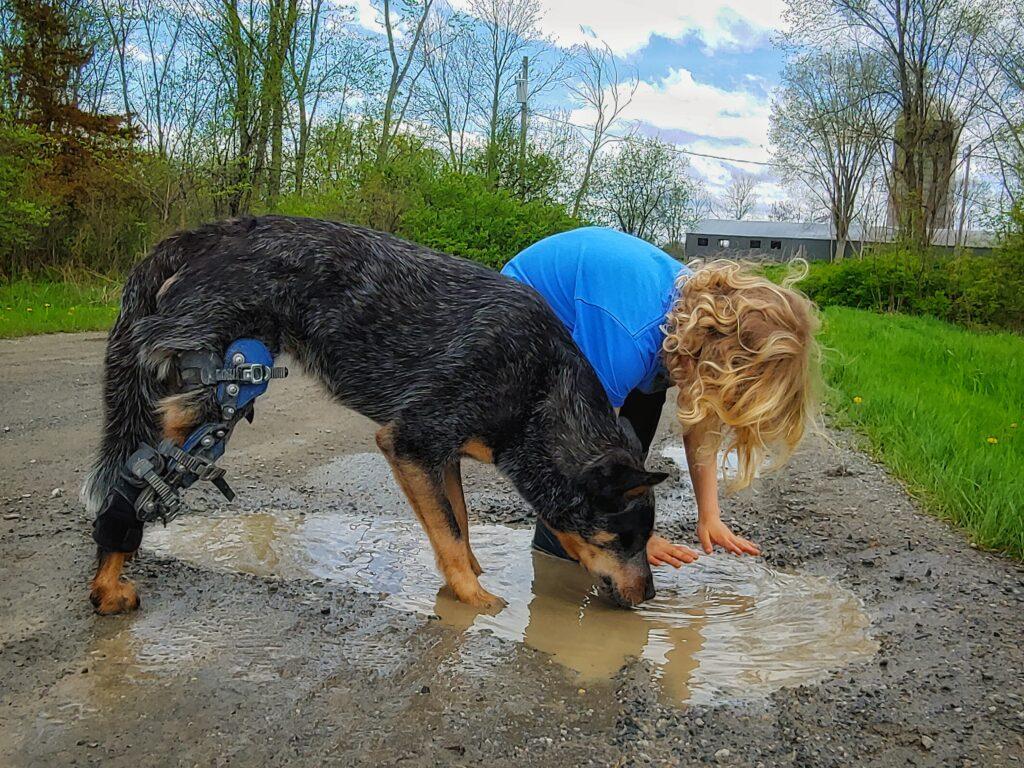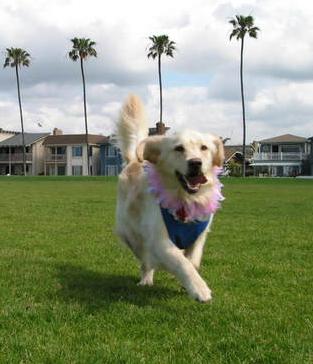Hey guys, this is Nikki, Lead Veterinary technician with Posh Dog Knee Braces. So, today I would like to talk about Laser Therapy for Dog’s with knee injuries ACL/CCL, or arthritis, and how it can help! First off, what is Laser therapy? Laser therapy is taking a simple beam of light to penetrate deep into the tissues and produce positive tissue changes. First used on hair regrowth, Laser therapy has been a growing success.
There are 2 types of treatment you will hear. Cold laser, which focuses on the surface of the skin, and blood circulation, while hot laser are for deeper tissues. Hot laser should only be done by medical professionals, as it is used for cutting and burning, as well as healing.

In most practices, we use low-level laser, or class IV laser therapy. Depending on the class of the laser, will tell you if it is something you can do from home or by a clinician. Quality laser equipment is very expensive, thus most will opt for therapy with their holistic vet, chiropractor, or veterinarian.
So, how do dogs react to having laser therapy done? They find it very relaxing. Laser therapy releases endorphins, so dogs usually find it relaxing and positive. Another benefit, is that your dog will not need to be sedated for laser, they can be resting and wide awake. There is no need to clip the hair away either, like other treatments. There is usually no side effects, the type of lasers used should not cause any burns to the skin.
So how will this help a dog with a ccl tear? Cold laser therapy for dogs with cruciate ligament injuries, restore health to damaged tissue cells by stimulating their ability to grow and survive, and heal naturally. It helps relieve pain and limping as well. If used with conjunction with an orthotic (brace) this would give your pup a good chance of fully recovering with less pain.
Please call or email with any questions! Poshintake1@gmail.com, or 509-412-3065. You can also leave us a message on our contact form or visit our Facebook page.
Thanks!
Read reviews check out our Google Reviews online. Click Here
Did you know a Posh Dog Knee Brace can help your Dog recover from a torn knee ligament, CCL injury, or ACL injury – without surgery? Many Dogs are not good candidates for knee surgery due to age, medical issues, and high surgical costs.
Dog knee procedures have a serious complication rate of over one in three, and their overall success rate is far below 40%.
Your dog can recuperate pain-free and without complications with the aid of a bespoke Posh Dog knee brace. By allowing your dog to develop scar tissue, our brace helps the wounded knee area heal in a manner similar to surgery.
Wearing a Posh brace, many Dogs have successfully recovered from a total CCL ACL tear without surgery.

Read reviews check out our Google Reviews online. Click Here
Custom-made braces can help your dog after knee surgery – and can sometimes be used in place of surgery.
Ten years have passed since WDJ explored “conservative management” – the nonsurgical treatment – of knee ligament injuries (see “Saying ‘No’ to Surgery,” February 2010). Since then, although surgery remains by far the most widely used knee injury treatment, consumer demand for complementary therapies, including the use of custom-designed knee braces, has grown.

The majority of custom canine braces are made using materials supplied by the brace maker and are based on leg models that were cast in a veterinary office or at the client’s house. The resulting cast and supporting measures are provided so that the brace can be custom-made to suit. Sometimes casting needs to be redone because the cast was improperly created or was damaged during shipping. The appointment raises the price of the brace if done in a veterinary hospital.
The 11-year-old, 77-pound Golden Retriever named Pasha, who inspired the creation of the Posh Dog Knee Brace, had a left hind limb injury. When Pasha’s veterinarian discovered a ruptured cranial cruciate ligament and torn meniscus, he advised emergency surgery, stating that delaying treatment would result in a similar injury to Pasha’s right leg, severe arthritis, and a lifetime of inactivity for the dog.
Although Florida residents Jim Morison and Beth Scanlon, Pasha’s owners, could afford the $5,000 procedure, they were concerned due to Pasha’s age and past health issues, which included a history of anesthesia-related complications. Pasha’s rehabilitation started when they decided against scheduling surgery and purchased a personalized canine knee brace.
Read full article visit: https://www.whole-dog-journal.com/health/canine-knee-injury-brace-yourself/
To purchase a Posh Dog Knee Brace – Click Here
Read reviews check out our Google Reviews online. Click Here
Many Customers have told us to share our story about how Posh Dog Knee Brace become a company. So here goes…

We make Dog knee braces, because we know they work, and some 60% of Dogs are not viable candidates for surgery, including geriatric Dogs, Dogs with other compelling medical issues, and Dog parents who simply do not have the average $3,000 + a cranial cruciate ligament surgery and post-op work is sold for.
Two and one half years ago, we saw how our own Pasha had a complete rupture of the cranial cruciate ligament in her left hind leg, as well as a severely damaged medial meniscus combined with crepitis [clicking/cracking] when she bent her leg.
Of course our former vet instantly stated that we HAVE to get the “state of the art” TPLO surgery from the top canine orthopedic surgical center in the southeast. This former vet insisted that if we did not get the surgery right away, Pashas other leg would “blow out” in less than 6 months, she would positively develop severe arthritis, and become lame, and the we would have to “put her down,” i.e. kill our beloved daughter. This form of emotional extortion was the wrong thing to say to us.
At that moment, we “put down” our relationship with this surgery-pushing vet. That weekend of Memorial Day 2013, we lived, 24-7, online collecting data about the various types of CCL surgeries, canine knee braces, and a lot more.
We learned of how this surgery is so lucrative, and so problematic, how certain esteemed vet publications questioned the outrageous number of CCL surgeries each year, how a Dog is FIVE time more likely to have a surgery on an injured knee than a person, and much, much more.
We read credible stories of other dogs with severe injuries, who recovered with a dog back leg brace, conservative management and supplements. We learned enough to then say; “no way” our beloved Golden Girl was going to have surgery, any of the seven types of Dog knee surgery, including the much heralded and over-promoted TPLO surgery, which, according to many vets, is not even 1% better or more effective than the surgeries costing half as much.
Most of what we found has been posted to our “Surgery Facts” tab. We are the only dog knee brace company who tells people the facts and serious risks about the dog knee surgery, as documented and shared by honest veterinarians.
Within 4 -5 weeks after she wore her 1st dog brace, which the vet insisted will NOT work [“GOTTA get the surgery!!”], the dreadful clicking/cracking of Pashas’ injured leg stopped and the crepitis has not re-occurred. Pasha was able to bear weight on her leg, with minimal pain. Her depression over her injured leg lifted. Yes, Dogs get depressed! Instead of a risky and huge setback of surgery, she began to heal – right away. Her leg developed the same scar tissue in her knee [stifle] as would have happened with the surgeries.
The companies who sold us the braces for an average of $900 + dollars had serious design flaws and used well, cheap, parts and velcro straps. We asked these companies to use high quality dog knee brace parts like chicago screws instead of pig metal screws, and ladder straps and micro buckles. They seemed offended that were telling them, with their years of experience, how to design a knee brace for our Dog, when we had no experience. Bottom line, they kind of told us to get lost. So we decided to make a brace that would exceed any dog knee brace on the market.
Pasha wore our first dog brace, and it outperformed any canine stifle brace out there. From there we invested sizable sums of money to start our company.
Although we likely could have removed the brace by January 2014, we left it on her ONLY for her daily 2 – 3 hour play sessions at the beach. As of May 2014, our baby Pasha has not worn a Dog knee brace. Her severely injured leg has healed completely, along with a regimen of supplements and conservative management.
I tell people that if you go to a car Dealership and ask if you should buy one of their cars, the salesperson will say: “YES – TODAY!!”
If you go to a canine orthopedic surgeon, rest assured 95% of the same breed of salesperson wearing a white lab coat, will say you should “GET THE SURGERY – right away.” If your veterinarian is like the former vet we went to, the vet may say, “the other knee will blow out and arthritis will happen and then you may have to kill your lame dog!”
Believe it or not, 3 weeks ago a Customer told me their vet said: “if you don’t get the surgery – we can go ahead and amputate the entire leg.” Astounding. This “veterinarian” obviously did not see a Dog with an injured leg; this vet saw a house and car payment limping into his office. There are some 80,000 veterinarians in the USA, and certainly not all of them are see “profit before the patient,” but plenty see only that. Look around.
Remember – 2 1/2 years ago, we were resoundingly told, by a person in a white coat whom we implicitly trusted, if we did NOT get the $5,000 ++ surgery immediately, Pashas other leg would fail in 6 months and she would have severe arthritis? [Rather despicable selling tactics].
Tick tock, tick tock… None of that happened. 2 1/2 years later, her right leg is just fine and she had no arthritis.
It seems quite logical that if a Dog DOES have the surgery, the uninjured leg has an extremely high chance of failing, due to increased load and stress during the 60-90 day horrible post op recovery [barring the high complication rate conceded by the veterinarian industry itself – see our “Surgery?” tab].
Before you trust the salesperson in the white coat, please put your Dog first, and consider the option of knee braces for Dogs, like the Dog knee brace we make just for Dogs with CCL injuries. That is all we make, and the Posh Dog Knee Brace is years ahead of all the others. We are the only company who makes a custom, high end dog knee brace, WITHOUT you or your vet having to make a cast.
See our real testimonials from real Customers page for some pictures of our current brace, working beautifully helping Dogs recover with no surgery and no casting required!
Give your Dog a BIG hug for us!!
Jim and Beth Morrison
To Order a Brace Click Here and visit our Facebook Page
Read reviews check out our Google Reviews online. Click Here